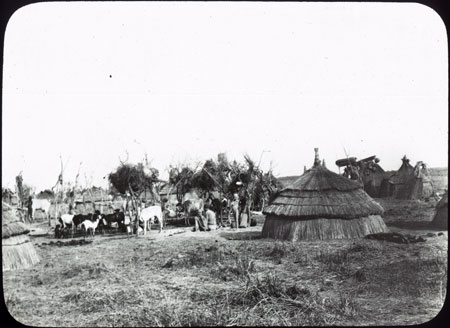Dinka dry season camp

82 x 82 mm | Lantern slide glass
MountDimension:
82 x 82 mm
Date of Print:
Unknown
Previous Other Number:
V.g.4 (346)
Accession Number:
1967.26.208
Description:
Small grass huts, cattle and youths, at the Dinka dry season camp near Shambe village on the Nile.
The Seligmans noted that during the dry season much of the village community of Shambe migrated next to the river to live in camps, building such smaller grass huts for the duration.
Photographer:
Charles Gabriel Seligman
Date of Photo:
1910
Region:
[Southern Sudan] El Buheyrat Shambe
Group:
Dinka ?Cic
PRM Source:
London School of Economics and Political Science
Acquired:
Donated 1967
Other Owners:
C. G. Seligman slide collection
Class:
Settlement , Shelter
Keyword:
Cattle Camp , Building House
Documentation:
Manual Catalogue in Related Documents File
Primary Documentation:
Accession Book Entry - [1967.26] THE LONDON SCHOOL OF ECONOMICS AND POLITICAL SCIENCE, HOUGHTON STREET, ALDWYCH, LONDON, W.C.E.
PER MR ANTHONY FORGE - SUDAN.
Box containing 309 lantern slides (3 1/4” x 3 1/4”) made from photographs taken by the late Professor C.
G.
SELIGMAN in various parts of the SUDAN.
All slides numbered and labelled.
Catalogue in file (“Seligman Slide Collection”).
Additional Accession Book Entry - [in pencil] 18 Parks Rd.
Manual catalogue entry (thermofax catalogue copy in folder '27-06 Seligman Slide Collection') - "V.g.4. Dinka dry season settlement at Shambe. (346)"
Note on lantern slide - "V.g.4. Dinka dry season settlement at Shambe. 346"
Manual catalogue entry (thermofax catalogue copy in folder '27-06 Seligman Slide Collection') - "V.g.4. Dinka dry season settlement at Shambe. (346)"
Note on lantern slide - "V.g.4. Dinka dry season settlement at Shambe. 346"
Other Information:
In C.G.
& B.
Seligman's Pagan Tribes of the Nilotic Sudan (London, Routledge 1932), page 137, they note that 'In the dry season - we are speaking specifically of the riverain tribes in the neighbourhood of Bor and Shambe - the whole community, men, women, and cattle, migrates to the neighbourhood of the river, living in small temporary huts (Shambe) or absolutely in the open (Bor).' [Chris Morton 18/10/2004]
Recorder:
Christopher Morton [18/10/2004] [Southern Sudan Project]

